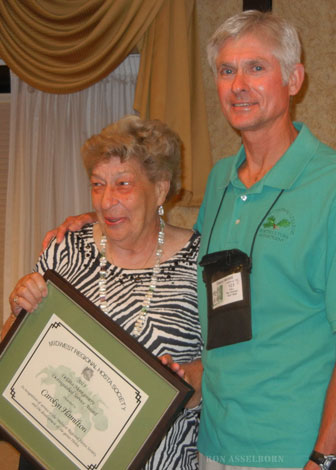|
Hotel
accommodations were superb – nice
rooms, good food, friendly servers, and plenty of centrally located
convention
space. Nine vendors
occupied a room
large enough to display all their wares. Hosta
favorites plus ones newly on the market,
Japanese maples, and concrete stepping stones, along with hosta-print
vests and
fairy gardens made their way from the vendor room to nearby car trunks.
Oh,
what a Ball! On
Friday
morning, the convention committee had arranged an optional tour of The
Gardens
at Ball. This was
not just row after row
of plants, but instead, acres of beautifully landscaped areas,
showcasing new
varieties of plants. An
hour long guided
tour provided a glimpse of the many types of seed trials underway. Some areas were dedicated to
sunny annuals and
perennials, while others displayed colorful shady alternatives. The many types of new coleus
caught my eye. A
favorite of our tour group was the ‘’living
wall.’’ One wall,
made of wooly pockets,
held shade plants. Another
tall frame
held vertically positioned trays of sun plants. There
was plenty of time after the tour to
wander the grounds, taking a longer look at the ornamentals and
vegetables we
will see in our local nurseries in the coming years. What
an inspiring way to start a garden
convention!
|
|
|
Ten
members opened their gardens to
visitors on Friday and Saturday. Each
garden had its own identity. Some
yards
were meticulously groomed, with not a damaged hosta leaf in view. Others promoted a more
natural look, with
native plants poking their heads amongst the hostas. Large,
beautifully grown hostas thrived in
abundance. Fairies
danced in troughs. The
soothing sounds of water greeted
conventioneers: waterfalls,
meandering
streams, ponds streaked with the gold of swimming fish, water splashing
down a
rock tower, and many bubbling fountains. Tall
giraffes nibbled at tree leaves; a
cheetah crawled down a dead tree; and black ducks quacked in their pen,
while a
rooster crowed in the distance. Stands
of hydrangeas, ligularias, and golden grasses, patches of sun-loving
daisies,
and coneflowers, even a butterbur, dotted garden beds and borders. Majestic oaks, walnuts, and
hickories provided
the high canopy hostas so love. Beautiful
tri-color beeches brightened many a landscape. We
came for the gardens and were not
disappointed.
For
the first time,
the MRHS convention used a drive-yourself concept, instead of buses, to
travel
to the various gardens. Conventioneers
were given annotated maps with driving instructions to each location. Many members used their own
GPS systems. Attendees
who chose not to drive were matched
with others willing to have a passenger or two. The
system was a huge success. This
method allowed people to visit the
gardens in any order and spend as much time in each, as they wished. Since hosts were not
overwhelmed with an
influx of fifty people at a time, they were able to present their
beautiful
gardens in a leisurely manner. There
was
still plenty of time for the camaraderie that buses provide during the
cocktail
hours, dinners, and at hostatality. Friday
afternoon seminars featured talks by Tom Micheletti and Mary Ann Metz. Tom began with a bit of
hosta history,
followed by a discussion of different hosta sizes and color variations. He showed how
the hosta, with its range of
foliage color and texture, can be incorporated into our landscape. Tom then switched to his
main topic of hosta
maintenance, by giving tips on plant division, fertilizing, diseases,
and pest
control.
Mary
Ann Metz expanded on the theme of
landscaping with hostas. She
contended
that the hosta is a great landscaping plant, which combines the three
elements
of design: color, form, and texture. Mary
Ann discussed these elements in more depth, using hosta pictures to
demonstrate
her points.
|
|
One of
the highlights of a hosta
convention is the Leaf Show. Row
after
row of glass bottles held leaves in a vast array of sizes and colors. Along one wall stood themed
arrangements using
hosta leaves; along another, were container plantings. Viewing these perfect
specimens, we appreciate
how much work there is to find a leaf with no damage, transport it to
the
hotel, then clean and prep it for display.
Friday
evening’s live auction was tense,
as bidders vied for that special plant to add to their gardens or
breeding
programs. Especially
coveted was Trudy
and Bruce Van Wyk’s Hosta ‘Emperor’s
Dragon’. The
popularity of “steakers”
continues, with many unusual donations fetching high bids.
Award
presentations highlighted the
Saturday night banquet. The
DeEtta
Montgomery Award for outstanding service to MRHS was presented to a
very
deserving and much loved member, Carolyn Hamilton. A
newcomer on the leaf show scene swept those
awards. Among
numerous other ribbons,
Rita Gindt-Marvig won the coveted Best of Show.
The
two days flew by in a flash. It
was soon time to bid adieu to old and newly
acquired friends. Many
thanks to Barbara
King, her committee, and the Northern Illinois Hosta Society for a
well-run,
thoroughly enjoyable event.
|
 |

